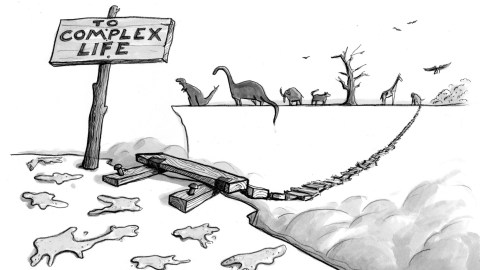Biology’s Black Hole Explained?

Biology has a “black hole” at its heart, says Nick Lane.
1. Lane can explain this “disturbing discontinuity,” and predict features of alien life (that’s despite biology’s “embarrassingly bad” predictive power + lack of laws comparable to physics).
2. Evolution’s small-each-useful steps generated flight 6+ times, and sight dozens, but “strikingly complex” leaps, like cloning → sex, just once.
3. Evolution took ~2 billion years to create complex cells (= eukaryotes) from bacteria (= prokaryotes). That’s ~51 trillion prokaryotic generations (~70 generations a day).
4. Prokaryotes have ~5,000 genes, but eukaryotes have ~20,000; they’re ~15,000 times larger, with ~200,000 times more energy per gene.
5. Indigestion enabled that energy advantage — one primitive cell engulfed another, but couldn’t digest it. They jointly survived (endosymbiosis) and coevolved, creating biology’s single big bang of complex life.
6. That engulfed cell begat all eukaryotic power plants, e.g., mitochondria, which work by pumping protons against an electrochemical gradient across a membrane (”the most counterintuitive idea in biology since Darwin”).
7. Lane believes all complex life faces similar energy and engineering challenges— extraterrestrials will be transmembrane proton-pumpers.
8. Transmembrane electrical fields reach ~30 million volts per meter ~ equivalent to a lightning bolt (our cells bottle lightning).
9. ATP molecules are life’s energy currency. A eukaryotic cell uses ~10 million ATPs per second.
10. Although it’s “hard to imagine a more preposterous arrangement,” ATP buys electron movement via chained quantum tunneling.
11. ~80 percent of cell energy goes to making proteins (2 percent DNA). Ribosomes are elaborate nanomachine protein factories (adding ~10 amino acids per second). A human liver cell has ~13 million ribosomes.
12. This energy and protein bonanza enables life’s “baroque complexity.”
13. Prokaryotic genomes are “sensible,” but eukaryotic genomes are a (hard to botch so badly) mess. E.g., onions and amoeba have more DNA per cell than humans.
14. Each human’s mitochondria (thousands per cell) daily pump as many protons as exist stars in the known universe.
15. Human brains are “wired up … like a [train] map … with 86 billion stations connected 30 trillion ways” (Tom Stoppard).
16. Using only the power of a light bulb (~130 watts) our bodies precisely orchestrate ~40 trillion cells, each “vastly more complex” than any silicon chip.
17. Lane sees no “universal trajectory towards complex life.” Proton gradients in hydrothermal vents will generate prokaryotes. But without an endosymbiotic energy big bang there’ll be no eukaryotes (no cell nuclei… sex… plants… animals… tech… ETs phoning home).
Illustration by Julia Suits, The New Yorker cartoonist & author of The Extraordinary Catalog of Peculiar Inventions





